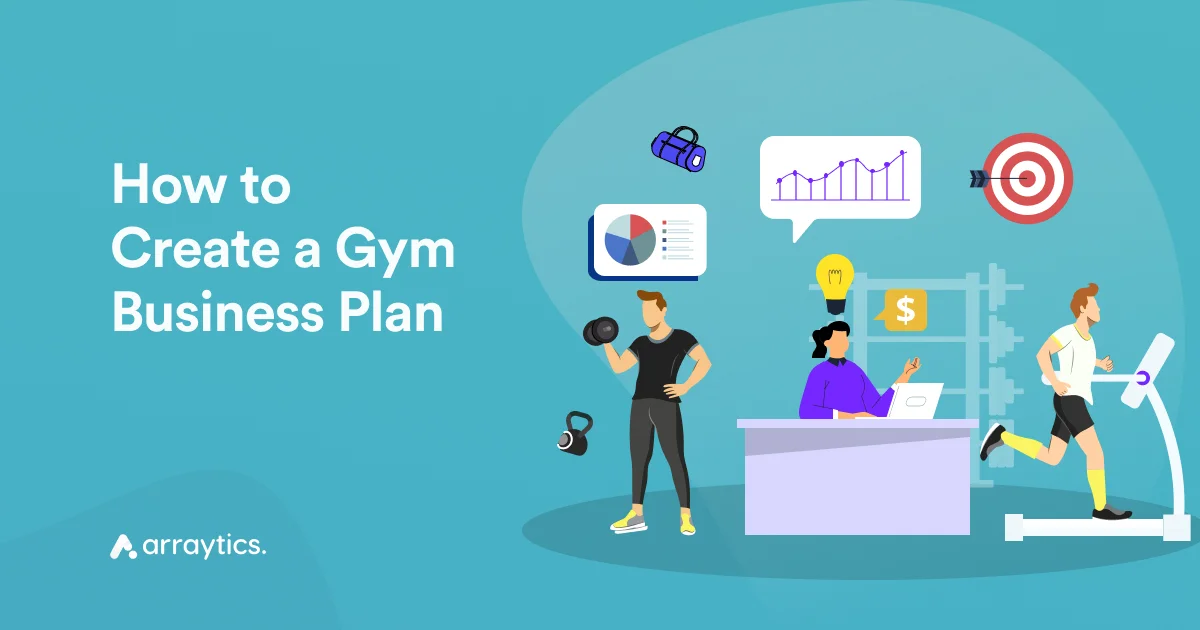Creating a Successful GYM Business Plan: A Step-by-Step Guide

The fitness industry is booming.
In the US alone, the health club industry revenue is projected to reach a staggering $33.9 billion by 2024 [STATISTA Gym revenue].
Fueled by a growing health consciousness and a desire for a more active lifestyle, gyms are no longer just a place to pump iron, they’re evolving into community hubs, offering a diverse range of fitness experiences.
If you’re passionate about fitness and have a dream of opening your own gym, a well-crafted business plan is your roadmap to success.
This guide will take you through the key steps of building a strong gym business plan, turning your vision into a thriving fitness center.
So, let’s get onto it.
But before we dive in, let’s talk about Time Management:
As a gym owner, your time will be precious. Juggling appointments, managing staff schedules, and keeping track of consultations can be overwhelming. This is where WP Timetics comes in.
This innovative appointment scheduling tool, built by the WordPress plugin powerhouse Arraytics, seamlessly integrates with your existing website, and allows you to efficiently manage all your gym’s appointments and class schedules. Free up your valuable time to focus on what matters most – creating a stellar fitness experience for your members.

How To Open Your Own Gym with A Rock-Solid Gym Business Plan: 7 Easy Steps
#1 Executive Summary:

The executive summary is a concise overview of your entire business plan, highlighting your gym’s key features, target market, financial projections, and competitive advantage. Think of it as the elevator pitch for your gym – it should be clear, compelling, and capture the reader’s attention in a short amount of time.
Here’s a breakdown of what to include:
- A brief description of your gym concept
- Your target market and its needs
- Unique selling proposition (USP) – What sets you apart?
- Financial projections – briefly mention your profit goals
- Funding requirements (if you are likely to).
These components alone can determine half the battle of your gym business plan, as your fitness club business needs to be clear-cut in the goals in the first place.
#2 Market Analysis

Understanding the fitness industry landscape is crucial to crafting a successful strategy. Here’s how to break down your market analysis:
a. Fitness Industry Overview
Provide a high-level overview of the fitness industry, including current trends, growth projections, and any factors impacting the market. Briefly discuss the increasing popularity of niche fitness studios like CrossFit or barre classes.
b. Identify Target Market and Customer
Who are you trying to reach? Are you targeting busy professionals seeking convenient after-work workouts or families looking for a gym with childcare options? Demographics, fitness goals, and income levels are all important factors to consider when defining your ideal customer.
💡 Here’s a WordPress Tip: Tools like Google Analytics can help you understand the demographics of your website visitors if you already have a fitness-related website. This data can provide valuable insights into your potential customer base.
c. Analyze Market Trends
Stay ahead of the curve by identifying current and emerging fitness trends. Is there a growing demand for boutique fitness studios offering personalized training? Are high-intensity interval training (HIIT) classes gaining popularity? Understanding these trends allows you to tailor your gym’s offerings to customer demand.
d. Competitor Analysis
Identify your direct and indirect competitors. Analyze their strengths and weaknesses, pricing strategies, class offerings, and target market. What makes your gym different? Highlight your unique selling proposition (USP), whether it’s state-of-the-art equipment, specialized classes, or a strong focus on community.
e. Marketing Programs: While crafting a gym business plan, it’s important to say your marketing strategy can be broad to big ideas. You can build different marketing programs after your research such as – advertisements, email marketing, traditional marketing, social media marketing, loyalty programs, PPC campaigns and anything else you would like to add in your marketing list.
# 3 Financial Plan
The financial plan is the heart of your business plan. It demonstrates the financial viability of your gym and outlines your funding needs. Here’s what to include:
- Startup Costs: This includes expenses like equipment, renovations, permits, licenses, marketing, and staff training.
- Operating Expenses: These are your ongoing costs, like rent, utilities, insurance, payroll, and marketing.
- Revenue Projections: Forecast your income based on membership fees, class packages, personal training sessions, and any retail sales. Break down projections by membership type and revenue stream.
- Profitability: Show how long it will take for your gym to become profitable (break-even point).
- Funding Requirements: If necessary, outline the amount of funding you need to launch and operate your gym.
#4 Build Services & Facilities
This section details the services and amenities your gym will offer, creating a compelling picture for potential members.
a. Gym Services
What kind of experience will your gym provide? Consider these factors:
- Class Offerings: A diverse range of classes caters to a wider audience. Options might include cardio, strength training, yoga, Zumba, Pilates, or specialty classes like spin or kickboxing.
- Personal Training: Offer personalized training sessions for members seeking individual guidance.
- Group Fitness: Group fitness classes foster a sense of community and can be a motivating way to exercise.
- Other Services: Consider additional services like nutritional consultations, massage therapy, or on-site childcare to enhance the member experience.
b. Equipment and Technology
Outline the equipment you’ll offer, considering your target market and budget. Free weights, cardio machines, functional training equipment, and exercise mats are essential staples. However, high-tech equipment like virtual reality fitness experiences or interactive fitness mirrors can be a differentiator.
💡 Here’s a WordPress Tip: WP Timetics is a user-friendly WordPress appointment booking plugin that is designed to schedule, book and meet your fitness clients done by either online or offline sessions. You can use this WordPress booking plugin as a mean of technology to automate half of your daily fitness operations and meet more clients on the roll.
c. Membership Options
Create tiered membership options to cater to different needs and budgets. Consider offering:
- Individual Memberships: This is the most common option, offering access to all gym facilities and classes.
- Family Memberships: Attract families by providing discounted memberships for multiple members.
- Student Discounts: Offer student memberships to tap into this budget-conscious demographic.
- Pay-as-you-go options: Cater to those who prefer flexibility with punch passes or class packages.
d. Pricing Strategy
Set competitive pricing that reflects the value proposition of your gym. Consider researching competitor pricing and tailoring your pricing strategy to your target market and unique offerings.
#6 Marketing and Sales

A well-defined marketing and sales strategy is crucial for attracting members and growing your business.
a. Marketing and advertising efforts
- Digital Marketing: Leverage social media platforms like Instagram and Facebook to showcase your gym’s facilities, classes, and success stories. Content marketing with blog posts and fitness tips establishes your gym as a credible source of information. Consider local search engine optimization (SEO) to ensure your gym appears in relevant online searches.
- Public Relations: Develop relationships with local media outlets to generate positive press coverage.
- Community Outreach: Partner with local businesses or health organizations to host events and increase brand awareness.
- Grand Opening Events: Create a buzz with a grand opening event offering free trials, special discounts, or giveaways.
b. Sales channels and customer acquisition strategy
- Website: A user-friendly website serves as your online storefront. Showcase your facilities, class schedules, membership options, and pricing clearly. WP Timetics seamlessly integrates with your website, allowing members to book appointments and manage their accounts online.
- Referral Programs: Incentivize existing members to refer friends with attractive referral bonuses.
- Free Trial Periods: Offer free trials to allow potential members to experience your gym firsthand.
c. Marketing Budget and Expenses
Allocate a realistic budget for your marketing and sales efforts. Track your return on investment (ROI) to measure the effectiveness of your campaigns and adjust your strategy as needed.
#7 Operations and Management Plan
A smooth-running operation ensures a positive member experience and staff satisfaction, and it’s important. It’s because opening a gym might be easy, but running it is no way the similar.
a. Day-to-Day Sessions
- Class Schedules: Develop a well-balanced class schedule that caters to different fitness levels and interests. TimeTecs.ai allows you to manage class schedules efficiently and communicate any changes to members seamlessly.
- Equipment Maintenance: Establish a regular maintenance schedule to ensure your equipment remains safe and in good working order.
- Cleaning and Sanitation: Maintain a clean and hygienic environment to prevent the spread of germs and ensure member safety.
b. Team/Staff Engagement
- Hiring Qualified Staff: Hire certified and enthusiastic staff who can create a welcoming and motivating atmosphere.
- Training and Development: Invest in ongoing training for your staff to ensure they stay up-to-date on the latest fitness trends and best practices.
- Staff Motivation: Create a positive work environment and incentivize your staff to deliver exceptional customer service.
c. Retentions and Offers
Member retention is crucial for long-term success. Here are some strategies to keep members engaged:
- Member Engagement Programs: Organize events, workshops, or challenges to foster a sense of community and keep members motivated.
- Personalized Attention: Get to know your members and their fitness goals. Offer personalized guidance and support to help them achieve their desired results.
- Reward Programs: Implement loyalty programs or reward systems to incentivize members to keep coming back.
- Special Offers: Offer periodic promotions or discounts to keep members engaged and encourage them to try new classes or services.
🙌 And there you go! You’ve successfully created a rock-solid Gym Business Plan in just 7 Steps!
Wrapping Up: Let’s Build Your Fitness Club Business
Now that you have an easy 7-step guide of gym business plan, it’s time to open your own gym and start daring to dream beyond.
With that journey started, you can try WP Timetics to see if it works within your budget to start your gym business plan and automate half of the operations in a few clicks.
Don’t forget to strengthen your step online once you start your offline business. Create a fitness website and allow customers to catch you while scrolling their feeds. This way, you can ensure reach to a wider range of customers and boost your sales rates.




